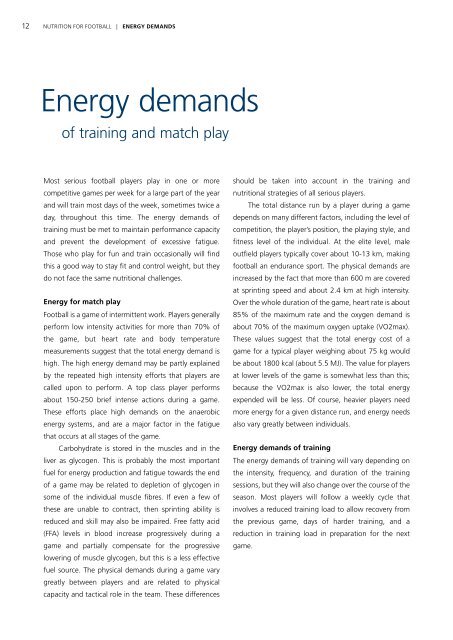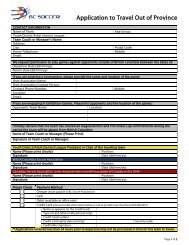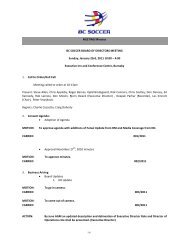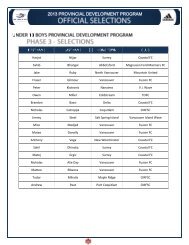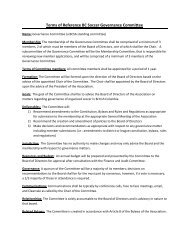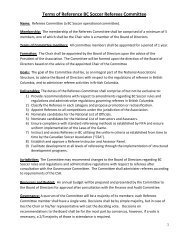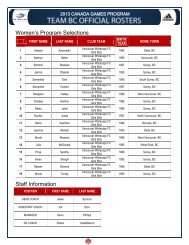Nutrition for football - FIFA.com
Nutrition for football - FIFA.com
Nutrition for football - FIFA.com
- No tags were found...
You also want an ePaper? Increase the reach of your titles
YUMPU automatically turns print PDFs into web optimized ePapers that Google loves.
12 NUTRITION FOR FOOTBALL | ENErgy dEMandsNUTRITION FOR FOOTBALL | ENErgy dEMands 13Energy demandsof training and match playMost serious <strong>football</strong> players play in one or moreshould be taken into account in the training andIn pre-season, the training load is usually at its<strong>com</strong>petitive games per week <strong>for</strong> a large part of the yearnutritional strategies of all serious players.greatest as players strive to reach full fitness <strong>for</strong> theand will train most days of the week, sometimes twice aThe total distance run by a player during a gameopening games of the season. Energy demands in aday, throughout this time. The energy demands ofdepends on many different factors, including the level oftraining session focused on fitness may exceed those oftraining must be met to maintain per<strong>for</strong>mance capacity<strong>com</strong>petition, the player’s position, the playing style, anda hard game. In sessions where the emphasis is onand prevent the development of excessive fatigue.fitness level of the individual. At the elite level, malerecovery and regeneration or on skill, the energy costThose who play <strong>for</strong> fun and train occasionally will findoutfield players typically cover about 10-13 km, makingwill be much less.this a good way to stay fit and control weight, but they<strong>football</strong> an endurance sport. The physical demands aredo not face the same nutritional challenges.increased by the fact that more than 600 m are coveredEnergy needsat sprinting speed and about 2.4 km at high intensity.The foods we eat and the fluids we drink provide <strong>for</strong> theEnergy <strong>for</strong> match playOver the whole duration of the game, heart rate is aboutimmediate energy needs of the body as well asFootball is a game of intermittent work. Players generally85% of the maximum rate and the oxygen demand isinfluencing body energy stores. Energy stores play aper<strong>for</strong>m low intensity activities <strong>for</strong> more than 70% ofabout 70% of the maximum oxygen uptake (VO2max).number of important roles related to exercisethe game, but heart rate and body temperatureThese values suggest that the total energy cost of aper<strong>for</strong>mance, since they contribute tomeasurements suggest that the total energy demand isgame <strong>for</strong> a typical player weighing about 75 kg would• Size and physique (e.g. body fat and muscle mass)high. The high energy demand may be partly explainedbe about 1800 kcal (about 5.5 MJ). The value <strong>for</strong> players• function (e.g. muscle mass)by the repeated high intensity ef<strong>for</strong>ts that players areat lower levels of the game is somewhat less than this;• fuel <strong>for</strong> exercise (e.g. muscle and liver carbohydratecalled upon to per<strong>for</strong>m. A top class player per<strong>for</strong>msbecause the VO2max is also lower, the total energystores)about 150-250 brief intense actions during a game.expended will be less. Of course, heavier players needThese ef<strong>for</strong>ts place high demands on the anaerobicmore energy <strong>for</strong> a given distance run, and energy needsThe energy needed <strong>for</strong> training and match play must beenergy systems, and are a major factor in the fatiguealso vary greatly between individuals.added to the energy required <strong>for</strong> normal daily activities.that occurs at all stages of the game.This will depend on physical activity at work and onCarbohydrate is stored in the muscles and in theEnergy demands of trainingother lifestyle factors.liver as glycogen. This is probably the most importantThe energy demands of training will vary depending onHow much food a player needs will depend largelyfuel <strong>for</strong> energy production and fatigue towards the endthe intensity, frequency, and duration of the trainingon the total energy needs, and there is no simple <strong>for</strong>mulaof a game may be related to depletion of glycogen insessions, but they will also change over the course of theto predict this. Energy needs depend not only on thesome of the individual muscle fibres. If even a few ofthese are unable to contract, then sprinting ability isreduced and skill may also be impaired. Free fatty acidseason. Most players will follow a weekly cycle thatinvolves a reduced training load to allow recovery fromthe previous game, days of harder training, and ademands of training and match play, but also onactivities outside the game. For those who traininfrequently, or where training sessions are short or easy,How much food a playerneeds will depend largely on(FFA) levels in blood increase progressively during agame and partially <strong>com</strong>pensate <strong>for</strong> the progressivereduction in training load in preparation <strong>for</strong> the nextgame.the energy demands will not be high. Similarly, energyneeds are lower during periods of inactivity such as thethe total energy needs.lowering of muscle glycogen, but this is a less effectiveoff-season or while a player is injured, and playersfuel source. The physical demands during a game varyshould adapt their food intake accordingly.greatly between players and are related to physicalcapacity and tactical role in the team. These differences


